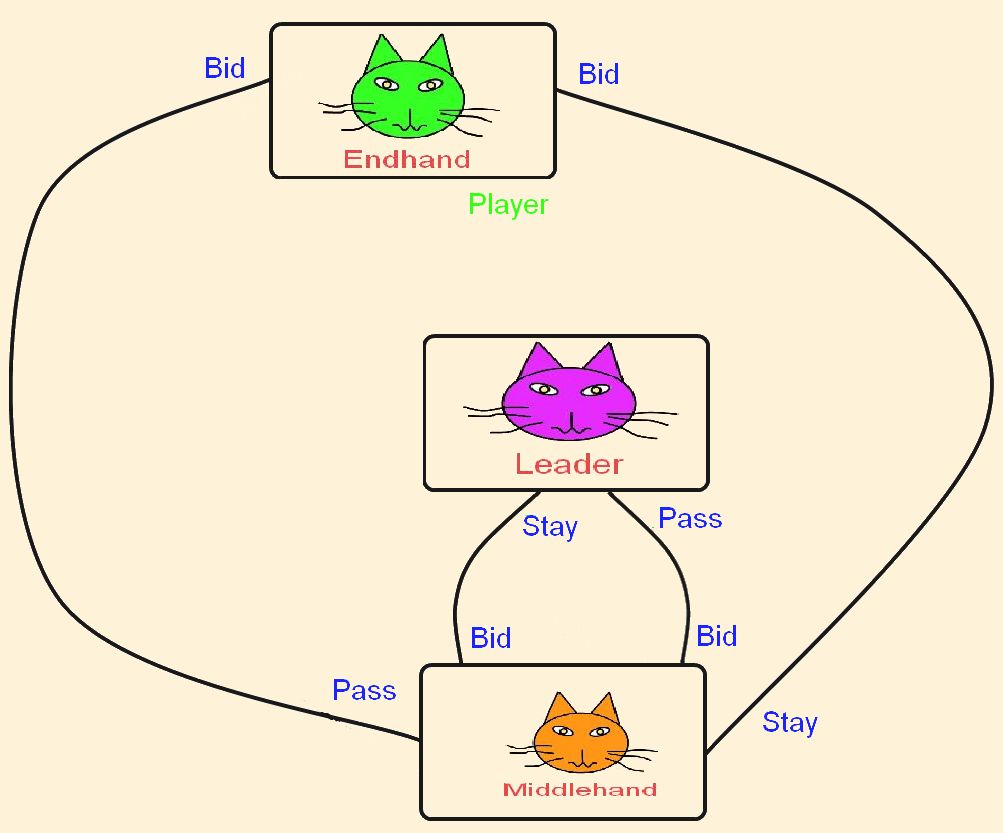
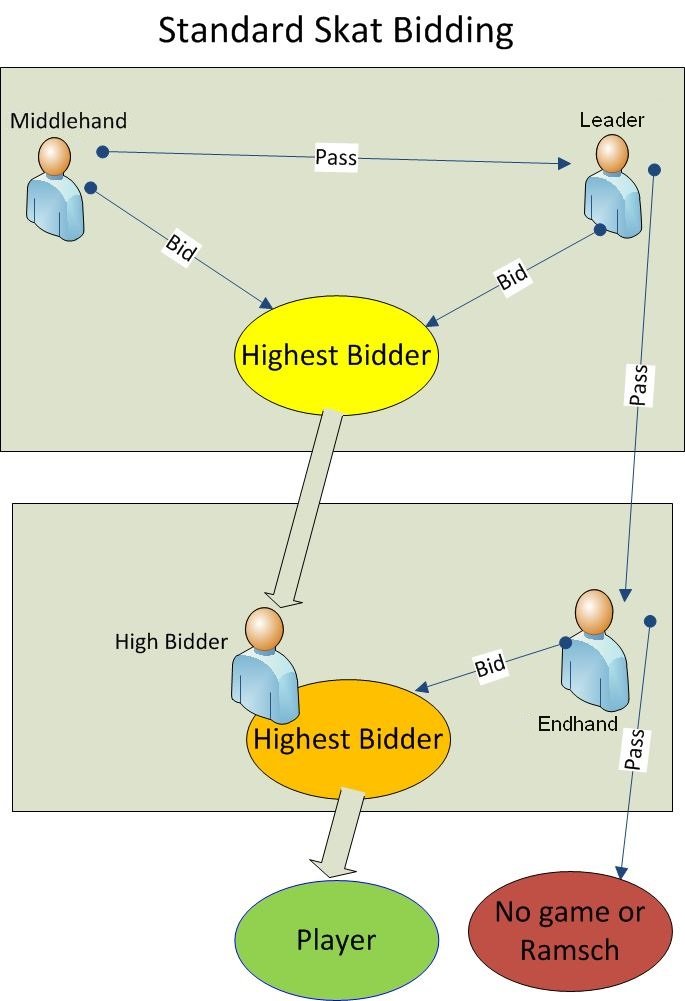 The following instructions detail the rules for North American Skat and several of it's variants. For the rules for the variant preferred by the German Skat clubs and the ISPA, please see our original Skat game rules.
Skat was first and foremost a German game developed in the 1800's and later brought to the Americas by German immigrants wanting a taste of home. Over time, revisions and changes were made to the game making this current North American version the version commonly encountered in the United States and surrounding areas.
The following instructions detail the rules for North American Skat and several of it's variants. For the rules for the variant preferred by the German Skat clubs and the ISPA, please see our original Skat game rules.
Skat was first and foremost a German game developed in the 1800's and later brought to the Americas by German immigrants wanting a taste of home. Over time, revisions and changes were made to the game making this current North American version the version commonly encountered in the United States and surrounding areas.
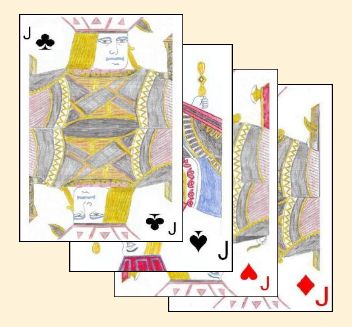 The ranking of the cards may vary depending on which particular suit is named trump for the hand (if one is named). Whenever there is a trump suit named (see below), the four highest ranking trumps are always the four jacks, ranked in the following descending order; Jack of Clubs (♣), Jack of Spades (♠), Jack of Hearts (♥), Jack of Diamonds (♦). After the four jacks, the remainder of the trump suit (in whichever suit might be named as trump in the hand) rank in the following order, from highest to lowest; Ace, King, Queen, 10, 9, 8, 7. The non trump suits rank in the following order, high to low; Ace, King, Queen, 10, 9, 8, 7. In addition, within the game of Skat the suits also have a ranking for various purposes within the game. This suit ranking from highest to lowest is as follows: Clubs(♣), Spades(♠), Hearts(♥), Diamonds(♦). In a few circumstances no trump suit is used in a hand, and in that case the rank of the cards is the expected ranking (from high to low): Ace, King, Queen, Jack, 10, 9, 8, 7. When there is a trump suit in the hand, the Jacks are then considered to be part of that trump suit and no longer belong to the suit marked on the face of the Jack. There are also occasions when the hand will be played with the four Jacks as the only trump. In these cases, these Jacks rank as described above and are part of their own "trump" suit and not considered as members of any other specific suit.
The ranking of the cards may vary depending on which particular suit is named trump for the hand (if one is named). Whenever there is a trump suit named (see below), the four highest ranking trumps are always the four jacks, ranked in the following descending order; Jack of Clubs (♣), Jack of Spades (♠), Jack of Hearts (♥), Jack of Diamonds (♦). After the four jacks, the remainder of the trump suit (in whichever suit might be named as trump in the hand) rank in the following order, from highest to lowest; Ace, King, Queen, 10, 9, 8, 7. The non trump suits rank in the following order, high to low; Ace, King, Queen, 10, 9, 8, 7. In addition, within the game of Skat the suits also have a ranking for various purposes within the game. This suit ranking from highest to lowest is as follows: Clubs(♣), Spades(♠), Hearts(♥), Diamonds(♦). In a few circumstances no trump suit is used in a hand, and in that case the rank of the cards is the expected ranking (from high to low): Ace, King, Queen, Jack, 10, 9, 8, 7. When there is a trump suit in the hand, the Jacks are then considered to be part of that trump suit and no longer belong to the suit marked on the face of the Jack. There are also occasions when the hand will be played with the four Jacks as the only trump. In these cases, these Jacks rank as described above and are part of their own "trump" suit and not considered as members of any other specific suit.
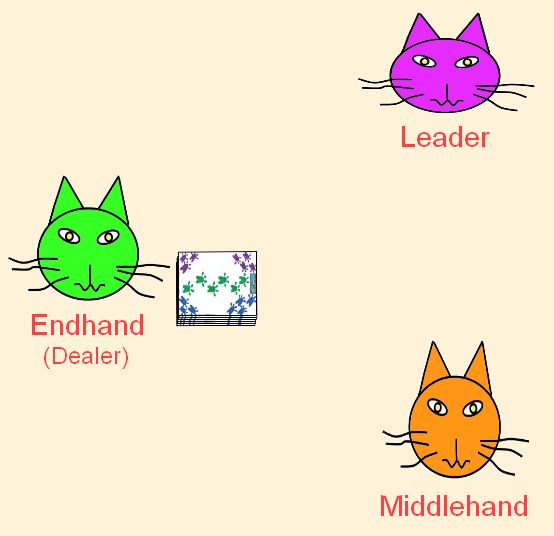 Once the dealing is complete, the players then pick up their hands for examination. Each player position in the game of Skat is given a specific name. The dealer is called Endhand (or Hinterhand in German). The player to the dealers immediate left is called the Leader (Vorhand) and the last player, to the dealers right, is called Middlehand (Mittelhand).
Once the dealing is complete, the players then pick up their hands for examination. Each player position in the game of Skat is given a specific name. The dealer is called Endhand (or Hinterhand in German). The player to the dealers immediate left is called the Leader (Vorhand) and the last player, to the dealers right, is called Middlehand (Mittelhand).
 |
| As an illustrative example say Middlehand, as the first bidder, names a bid of 10. Leader, believing he can exceed this bid simply states Stay. Middlehand then names a higher bid of 18. Leader does not intend to equal this bid, so says Pass. At this point Endhand may enter the bidding, in this case he bids 20. Middlehand then responds with Stay. Endhand then bids 28 to which Middlehand says Pass. This concludes the auction, with Endhand as the high bidder becoming the Player and provided the opportunity to name the Game. |
| Game Name | Trump? | Use Skat | Score | |||
|---|---|---|---|---|---|---|
| ♣ | ♠ | ♥ | ♦ | |||
| Tournée | Yes | Yes | 8 | 7 | 6 | 5 |
| Solo | Yes | No | 12 | 11 | 10 | 9 |
| Grand Tournée | Jacks Only | Yes | 12 | |||
| Grand Solo | Jacks Only | No | 20 | |||
| Gucki Grand (Guckser) | Jacks Only | Yes | 16 | |||
| Nullo | None | No | 20 | |||
| Grand Ouvert | Jacks Only | No | 24 | |||
| Null Ouvert | None | No | 40 | |||
| Ramsch | Jacks Only | No | 10 | |||
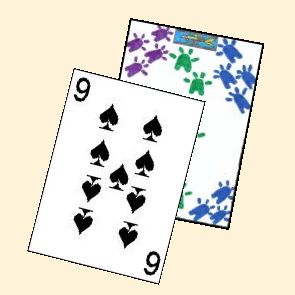
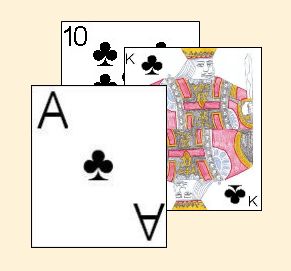
|
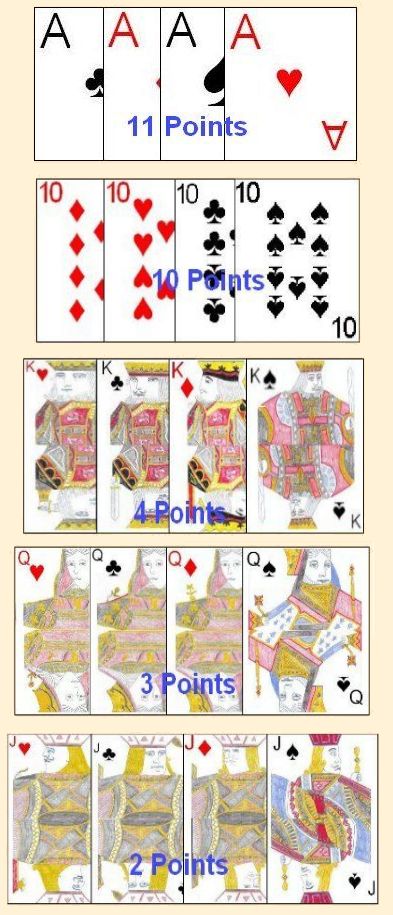
|
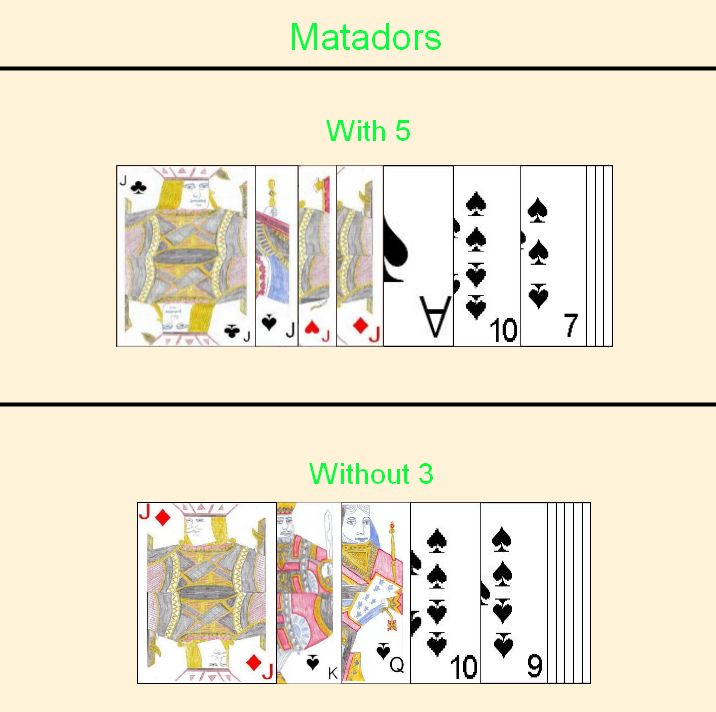
|
| As an example, in a hand with Spades as trump, a hand containing the trump cards shown in the top hand would be said to be "With" 5 matadors. Similarly, in another hand where Spades was set as the trump suit, a player having the bottom trump cards would be said to be "Without" 3 matadors. |
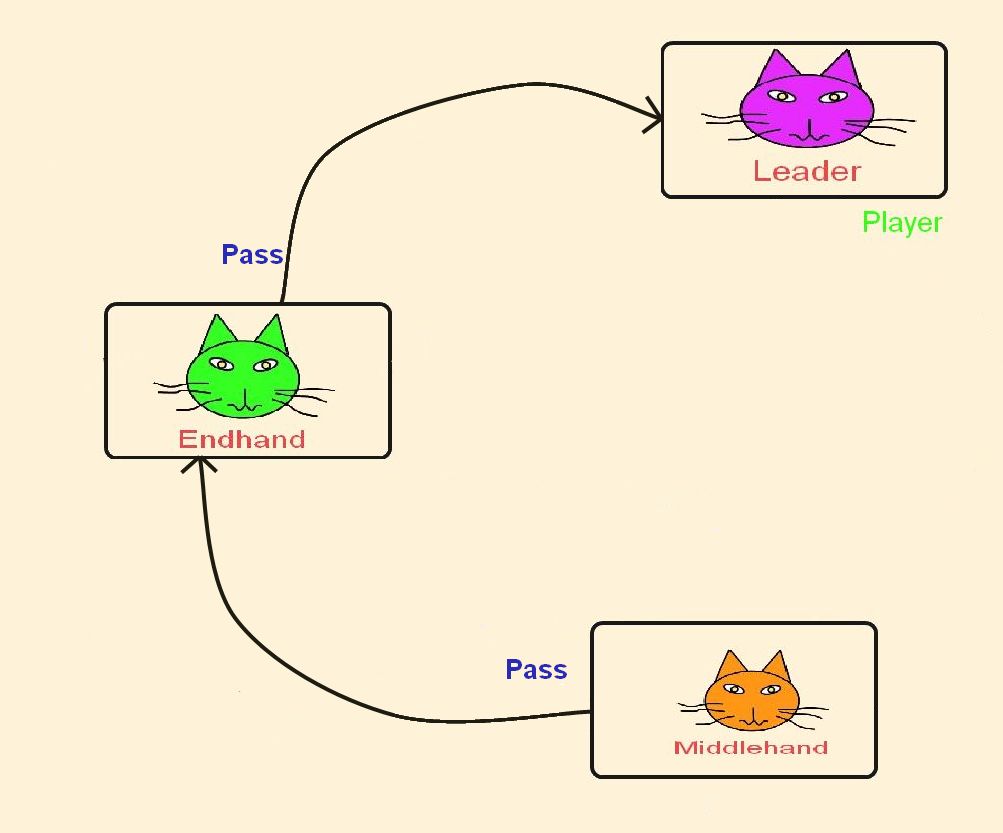 |
| If both Middlehand and Endhand pass, Leader names the game without bidding, often electing to play the hand at Ramsch. |
| Game Name | Trump? | Use Skat | Score |
|---|---|---|---|
| Gucki Nullo | None | Yes | 15 |
| Gucki Nullo Ouvert | None | Yes | 30 |
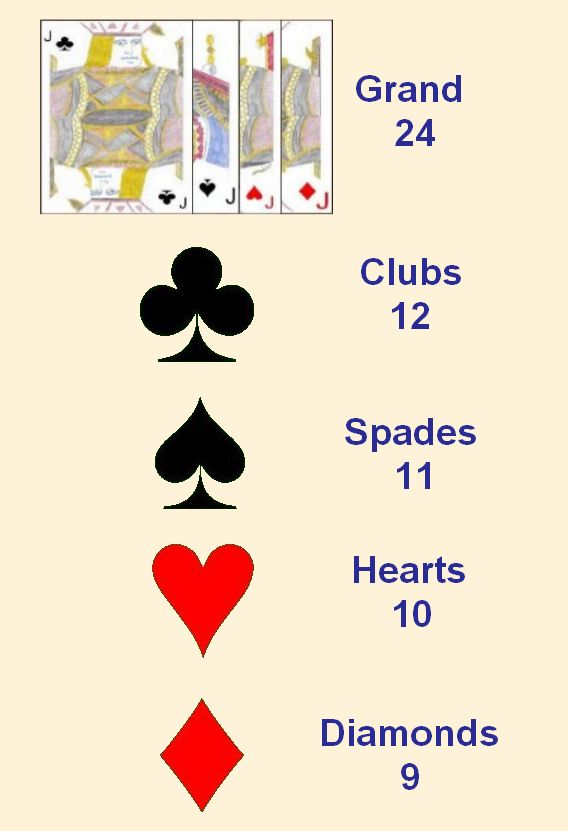 As in the parent game, the player to the dealers left (Leader) always leads to the first trick, regardless of who is the high bidder.
The base values of the games are also slightly different from the classic game, as follows:
As in the parent game, the player to the dealers left (Leader) always leads to the first trick, regardless of who is the high bidder.
The base values of the games are also slightly different from the classic game, as follows:
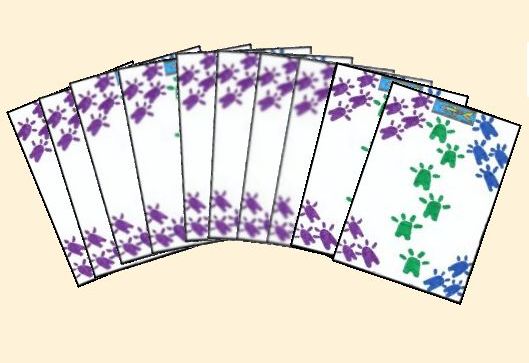 | 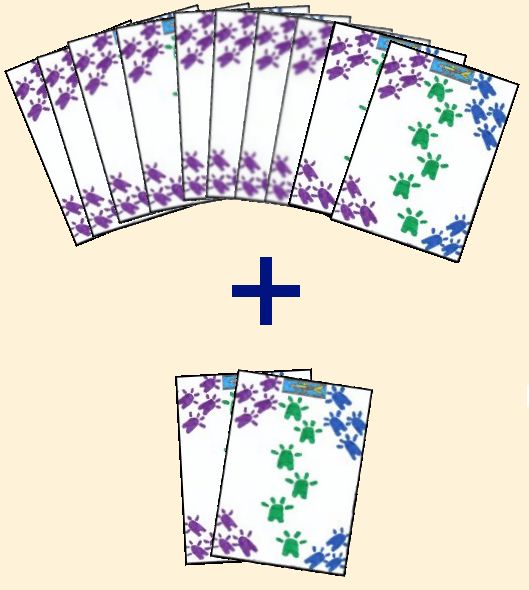 |
|
|---|---|---|
| Hand Game | Skat Game | |
|
|
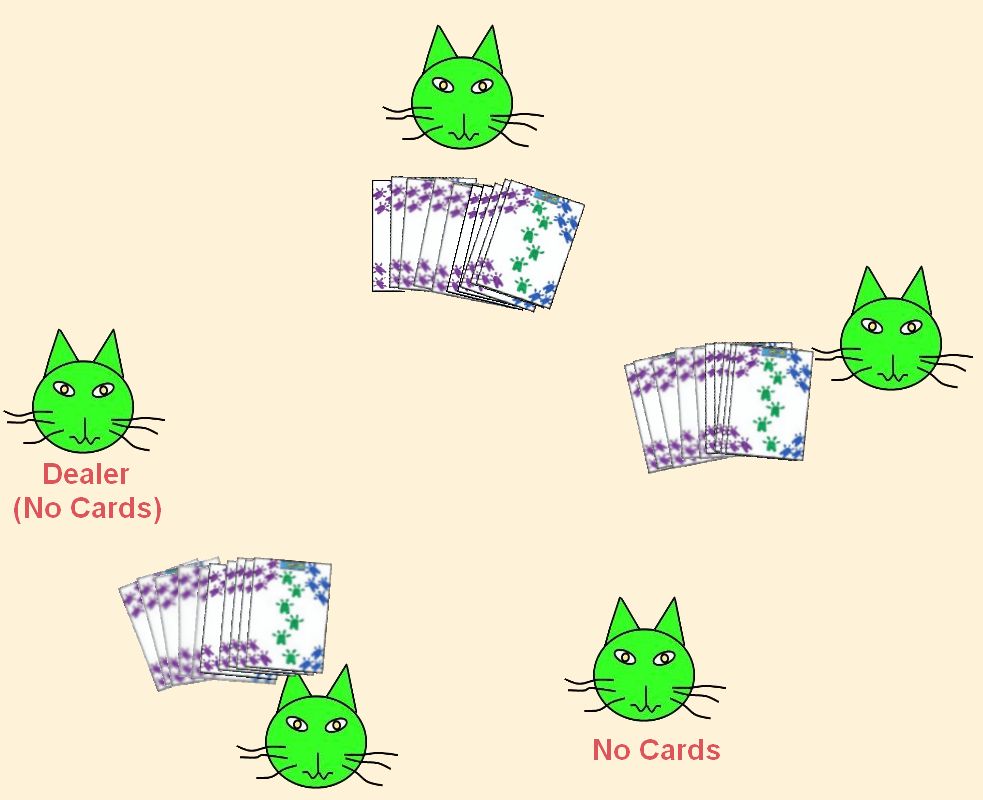 Skat for Additional Participants:
Skat for Additional Participants: